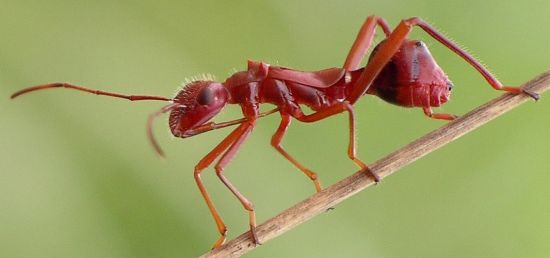by Valerie
May, 2009Texas Bow-legged Bug
While this insect might look like an attractive red ant, that identification would be way off the mark. This is actually the nymph of a true bug in the order Hemiptera and the resemblance to a member of the order Hymenoptera (wasps, ants and bees) is no coincidence. The Texas bow-legged bug (Hyalymenus tarsatus) belongs to a small family called Alydidae, the broad-headed bugs. They are so named because of the constriction where the head attaches to the thorax; it's not so much that their head is broad but that their neck is slender. If it is still hard to believe that this is not an ant, just look at the mouth. Ants have a pair of biting jaws while this imposter still retains its true bug mouth: a jointed tube through which it sucks liquids. So why would a bug so closely imitate an ant? Texas bow-legged bugs have no real defenses against predators. They cannot sting, bite, or produce a bad taste. Many insects and even spiders that are small enough for the masquerade to work emulate ants, which are one of the better defended groups among insects. Ants usually are found in large numbers, they can sometimes sting, they can bite, and they contain formic acid which causes them to taste bad to many predators. This particular mimic is one of the best there is, and it often fools people as well as its natural predators. This species is very common in the Austin area, and the nymphs can be found in gardens on a variety of plants. They feed by sucking liquids, preferring seeds and pods, but also utilizing leaves and stems. There are only a handful of broad-headed bug species, and this one is the most likely to be encountered. The nymphs are not usually so red; they come in a wide variety of grays, browns, blacks, and tans, as well as many combinations of those colors. In fact, one way to tell they are not ants is that they are much more colorful and sometimes larger than most ants. The adult Texas bow-legged bugs continue with the mimicry, but instead of looking like ants, they resemble some wasps of the family Sphecidae. They are not nearly as convincing in their deception as the nymphs, but they have markings, a body shape, and flight habits that do give the impression of a wasp, at least enough to make most people react when one flies past. |